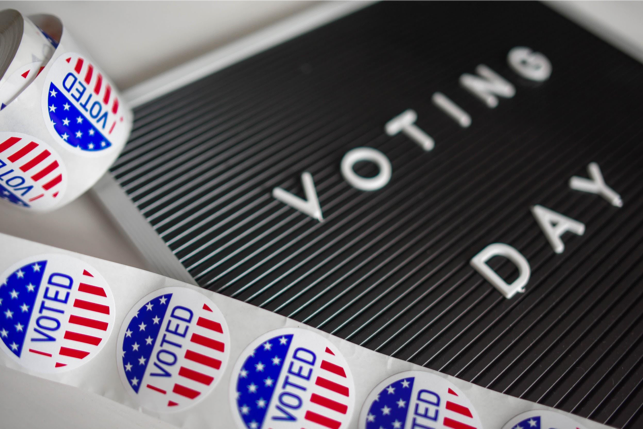If you’ve been following our blog throughout the year, you’ve likely read about the various digital marketing updates and trends that took place. From political involvement to the rise and fall of popular websites, 2018 has been a year of drastic changes. Here are the top five digital marketing stories from this year:
Social Media Gets Political

2018 was a big election year for America; the country saw its highest voter turnout for the midterms since 1966. While numerous factors contributed to America’s highly politicized environment, it’s undeniable that social media and digital marketing influenced political fervor and played a part in the election.
Back in February, Facebook announced that it would implement more stringent measures to vet potential political advertisers by having anyone referencing a politician in their ad utilize a verification code delivered via certified U.S. mail. The new policy was meant to prevent outside interference in U.S. elections, but caused some controversy when it blocked neutral news content and non-political ads.
Then in September, Nike released an ad campaign featuring Colin Kaepernick and the tagline, “Believe in something. Even if it means sacrificing everything.” Nike’s support of Kaepernick’s previous protest against racial inequality sparked controversy throughout the country. Customers took to social media to express their approval of or anger over the ad’s political message.
Snapchat also got involved in politics that month by releasing a new feature to help American adult users register to vote. Instagram similarly encouraged users to vote by partnering with TurboVote to spread information about registration and polling locations.
Finally, Taylor Swift explicitly stated her political leanings in an October Instagram post that backed a Tennessee Democrat and encouraged fans to get out and vote. Her post was directly correlated with an increase in voter registration, showing the impact of influencers on their followers.
Privacy Becomes a Hot Topic

The Cambridge Analytica scandal around the beginning of the year revealed that the personal data of more than 50 million Facebook users was purchased and utilized by a data-mining company. The scandal prompted Mark Zuckerberg to release statements apologizing for the company’s “breach of trust,” and forced Facebook to reevaluate its policies regarding the protection of user data.
The European Union’s implementation of the General Data Protection Regulation (GDPR) in May was another event that prompted social media sites to review their privacy practices. Twitter, Instagram, and numerous other sites all updated their privacy policies in order to comply with the EU’s new rules, which even inspired a meme about just how often users were being contacted about the changes.
Google+ Bites the Dust 
Nearly seven years after its launch, it was announced in October that Google+ would be shut down over the next several months. Although the social media platform was initially popular, various factors influenced its demise. Beginning in 2014, popular features were broken up into different services (such as Google Play Games and Google Photos), hashtags were removed from posts, timelines were shaped by algorithms, and more. The site even became overrun by spam bots earlier this year.
In addition to those not-so-user-friendly features, journalists reported that Google+ had exposed the personal information of nearly 500,000 users. The bug was active over the past few years and could have given third parties access to sensitive information stored on the site. Yet Google never disclosed the issue to the public out of fear of regulatory scrutiny.
So despite Google’s efforts to promote its own social media platform, Google+ simply wasn’t as popular or successful as its competitors and ultimately had to go.
Social Media Platforms Increase E-Commerce Opportunities

Snapchat announced in September that it would team up with Amazon to help users purchase the items they come across. By simply scanning an object or barcode, the Snapchat app can show users the same or similar products for sale. Once the user clicks on the item, they are rerouted to Amazon where they can place an order.
Earlier that same month, Instagram also released shoppable posts in Stories with links connecting directly to the specific products featured.
Similarly, Pinterest released a new ‘Product Pins’ feature in October to help users purchase items they see in their feeds. The new pins provide pricing and stock information, as well as a link to the vendor’s checkout page.
Amazon Makes Moves
Quite a bit happened with the e-commerce giant in 2018. Earlier in the year, Amazon announced new programs that would start delivering packages directly into the homes and car trunks of customers. The company also announced new perks for Prime members, including money back on Whole Foods purchases and free Whole Foods deliveries – further linking its membership program with the popular supermarket chain it acquired last year.
In May, Amazon decided to end all Google Shopping ad campaigns (a move that will help smaller advertisers see results on Google Shopping). Then in June, a new report was released that indicated Amazon’s eCommerce market share is growing at a rapid rate. As of the report, the company owned more than 90% of the market share in five product categories including batteries, home improvement tools, and skin care items. As one article by MarketingLand pointed out, “retailers still have opportunities in private labels and other categories, but will have a hard time competing on commodity products.”
Amazon also discussed the possibilities of “voice-assisted product placement” on its Alexa device in September, after reportedly speaking with consumer brands about potential advertising opportunities back in January.
With its partnerships, acquisitions, and ever-changing business model, digital marketers should continue to keep an eye on this dynamic company.






